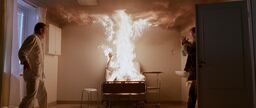The film describes the story of the 12-year-old boy Oscar and the female vampire Ellie. Ellie teaches Oscar to become braver, and Oscar inspires Ellie's desire for love. But the situation of the two is similar, both of them are equally lonely. It shows the loneliness of human nature and the darkness of society, and integrates more elements. The film is unique in the way of camera movement. At the beginning of the story, the director uses the movement method of pushing the camera to show the protagonist Oscar, and the director uses the following camera to highlight the loneliness and loneliness of the protagonist Oscar. The director uses various detailed descriptions of pushing shots to show the audience that his hobby is to collect news of various murders in the newspaper, wielding a knife to vent his anger on a tree, he longs for friends, but has no friends. When the heroine Ellie appeared on the stage, the director also used the movement method of pushing the camera to highlight the details of Ellie's lips turning black and blood stains between her nails, making the audience curious about Ellie, and Ellie's different characteristics from her peers. With very different, the important plot is highlighted. The director used Ellie's black lips and blood between her fingernails to highlight a dramatic element to express the specific theme of the film. The film begins with snowflakes flying all over the sky, falling in slow long takes, telling us that this is a story that takes place in the middle of winter. It also sets the tone for the film's poignant and pure tone. The director is also very flexible in the use of depth of field, dexterously creating a tense atmosphere, and shooting snow scenes through large scenes, the sense of perspective of elements such as roads, street lamps, and buildings reflects the visual experience of the far, middle and near of the picture. By blurring the foreground or background with a small depth of field, creating suspense and making the audience more eager to understand what happens next. For example, at the beginning of the film, the director uses a small depth of field to create a classroom atmosphere and highlight the loneliness of the protagonist Oscar, which reflects Oscar's situation in school and his withdrawn personality. The director's use of mirrors is also very clever. In the film, mirrors are often used to show other spaces. The mirrors more reflect the characters' inner thinking and torture, and also show the audience another space. For example, when Oscar went home after being beaten and his mother was cooking at home, the director skillfully used the mirror to show Oscar's nervousness and panic when he asked about the injury on his face. The overall tone of the film is colder, which presents the audience with a dignified and sad visual experience. The beginning of the film indicates the sad ending. The lack of color and low contrast make the picture of the film heavier and more mysterious, and it highlights the whole film. The theme also easily reflects the tense and dark atmosphere of the characters when they are indoors. When important plots occur, the film uses contrasting techniques to form a strong sense of contrast to the picture, making the picture present a tense atmosphere. For example, when Oscar resisted in the snow, the little boy's red sweater formed a sharp contrast with the bright snow color, highlighting the little boy, forming a strong sense of contrast, and making the picture present a tense atmosphere. And when Ellie's waiting for the food target under the bridge, the whole picture is black, and only Ellie's target and Ellie's shadow can be seen. It is also easy to reflect the tense and dark atmosphere of the characters when they are indoors. The horror brought about by the instant freezing of the scene is also very unforgettable. There is darkness in the film, but its essence has always been lurking in the relationship between Oscar and Ellie, and has never strayed from it. The film's use of scenes is also very clever, and the director's use of scenes creates suspense for the audience. When Oscar and Ellie met for the second time, the distance between the two became significantly closer. The director gave a close-up of the Rubik's Cube, and a small Rubik's Cube became the carrier of the emotional transmission of the two children. When Oscar plucked up the courage to beat his classmates who bullied him with a wooden stick, the director used a close-up shot to shoot the bullying boy, first filming his facial expressions and then his ears after being beaten. Suspense, after being beaten, red blood drips onto the snow, which brings great visual experience to the audience. A child in a single-parent family is lonely, and what he expects is to meet another person who can share that loneliness with him. And for Oscar, Ellie is the one who can share loneliness. The director's use of all parties reflects the tense atmosphere and dark scenes. For loneliness, Oscar does not think it is his own reason, and Ellie is not aware of his own problems, neither of them have found the reason for their true loneliness. A child in a single-parent family is lonely, and what he expects is to meet another person who can share that loneliness with him. And for Oscar, Ellie is the one who can share loneliness. The director's use of all parties reflects the tense atmosphere and dark scenes. For loneliness, Oscar does not think it is his own reason, and Ellie is not aware of his own problems, neither of them have found the reason for their true loneliness. A child in a single-parent family is lonely, and what he expects is to meet another person who can share that loneliness with him. And for Oscar, Ellie is the one who can share loneliness. The director's use of all parties reflects the tense atmosphere and dark scenes. For loneliness, Oscar does not think it is his own reason, and Ellie is not aware of his own problems, neither of them have found the reason for their true loneliness. The film's use of scenes is also very clever, and the director's use of scenes creates suspense for the audience. When Oscar and Ellie met for the second time, the distance between the two became significantly closer. The director gave a close-up of the Rubik's Cube, and a small Rubik's Cube became the carrier of the emotional transmission of the two children. When Oscar plucked up the courage to beat his classmates who bullied him with a wooden stick, the director used a close-up shot to shoot the bullying boy, first filming his facial expressions and then his ears after being beaten. Suspense, after being beaten, red blood drips onto the snow, which brings great visual experience to the audience. A child in a single-parent family is lonely, and what he expects is to meet another person who can share that loneliness with him. And for Oscar, Ellie is the one who can share loneliness. The director's use of all parties reflects the tense atmosphere and dark scenes. For loneliness, Oscar does not think it is his own reason, and Ellie is not aware of his own problems, neither of them have found the reason for their true loneliness. The film's use of scenes is also very clever, and the director's use of scenes creates suspense for the audience. When Oscar and Ellie met for the second time, the distance between the two became significantly closer. The director gave a close-up of the Rubik's Cube, and a small Rubik's Cube became the carrier of the emotional transmission of the two children. When Oscar plucked up the courage to beat his classmates who bullied him with a wooden stick, the director used a close-up shot to shoot the bullying boy, first filming his facial expressions and then his ears after being beaten. Suspense, after being beaten, red blood drips onto the snow, which brings great visual experience to the audience. A child in a single-parent family is lonely, and what he expects is to meet another person who can share that loneliness with him. And for Oscar, Ellie is the one who can share loneliness. The director's use of all parties reflects the tense atmosphere and dark scenes. For loneliness, Oscar does not think it is his own reason, and Ellie is not aware of his own problems, neither of them have found the reason for their true loneliness.
View more about Let the Right One In reviews











